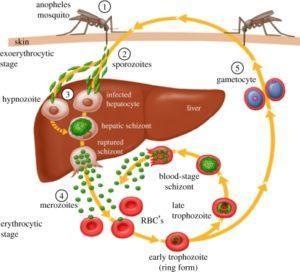
Vaccines against malaria ( Hill A (2011). “Vaccines against malaria”. Philosophical Transactions of the Royal Society B. DOI:10.1098/rstb.2011.0091)
RTS,S/AS01E is the most advanced Malaria vaccine. However, due to its low efficacy and waning of vaccine-induced responses in infants and children, it has not been endorsed by the World Health Organisation. This has highlighted the need for detailed understanding of malaria vaccine induced immunity, with the aim of improving vaccine efficacy and ensure long-lasting immunity of future vaccines.
Moncunill et al. performed an in depth analysis of cellular immunity -Th1, Th2, Th17, Tfh, regulatory and cytotoxic T cell functions as well as T cell memory profiles- associated with RTS,S/AS01E vaccination in children between 5-17 months from Malaria endemic countries.
Moncunill et al. observed an induction of robust vaccine-specific memory CD4 T cells to circumsporozoite protein (CSP) and Hepatitis B surface antigen (HBsAg), antigens present in the RTS,S/AS01E. In spite of previous hepatitis B vaccination in the cohort, RTS,S/AS01E induced significantly higher proportions of HBsAg-specific CD4+ T cells in RTS,S/AS01E-vaccinated compared to comparator (rabies vaccine) vaccinated children. Illustrating that previous hepatitis B vaccination does not impair induction of HBsAg-specific T cells.
Additionally, Moncunill et al. observed significant induction of TNF-a, IL-2 and CD154 functional responses by CSP- and HBsAg-specific CD4+ T cells. However, no significant production of IFNg, IL-4, IL-10, IL-13, IL-17, IL-21, Granzyme B and CD107a by CSP- and HBsAg-specific CD4+ T cells in response to vaccination were observed. Interestingly, Moncunill et al. observed higher HBsAg-specific CD4+ responses compared to CSP-specific CD4+ responses to the RTS,S/AS01E with vaccine response proportions of 68.8% and 21% respectively. Suggesting that HBsAg is more immunogenic than CSP in these individuals. Alternatively, this observation could be due antigen preparation of the vaccine were antigen-load is at a ratio of 4:1 between HBsAg and CSP. Moncunill et al. also observed that CSP-specific CD4+ T cells were predominantly effector memory and expressed TNFa±IL-2±CD154± poly-functional profiles. Where as, the vaccine induced both HBsAg-specific central and effector memory cells, with TNFa±IL-2±CD154±IFNg± poly-functional profiles and effector memory cells that were capable of producing IL-21.
In summary, Moncunill et al. demonstrated that RST,S/AS01E is capable of inducing CD4+ CSP- and HBsAg-specific memory cells in vaccinated children. The strong induction of central and effector memory cells in response to HBsAg suggests that the vaccine is capable of inducing long term immunity.
Journal: Moncunill, G. et al., 2017. RTS,S/AS01E Malaria Vaccine Induces Memory and Polyfunctional T Cell Responses in a Pediatric African Phase III Trial. Frontiers in Immunology, 8(AUG), p.1008.
Article by Cheleka AM Mpande











